Canary Types...
Hundreds Of Breeds
But Just Three Canary Types.
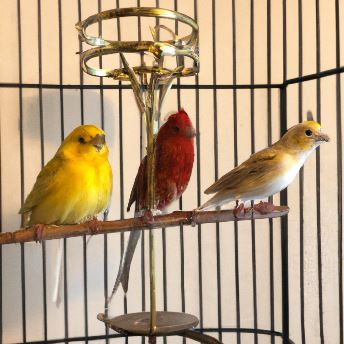
There are hundreds of breeds of canary in the world that can be classified into just three distinct canary types.
Over the centuries some canaries have been bred to be great singers, others have been bred to have certain markings and shapes, and still others have been bred to have a certain color.
So, domestic canaries can be divided into three basic groups or "types".
FREE Email Course.
Sign up below and get the 5 part email course: "The #1 Problem You Will Face As A Canary Owner"
Three Canary Types
- Type canaries
- Color canaries
- Song canaries
First let's talk about...
1. Type Canaries
Type canaries are bred for a specific physical trait or shape with little or no regard for the birds song or color.
Type canaries can be seen in many strange and wondrous shapes and sizes. From small to large to humpbacks to frilled and crested. Some of the most popular Type canaries are...
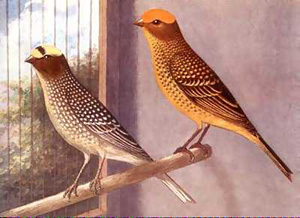 Canary Types Include The Lizard Canary
Canary Types Include The Lizard CanaryThe Lizard Canary with markings and colorations reminiscent of a lizard's scales. The lizard canary was bred in the early 1700's in France.
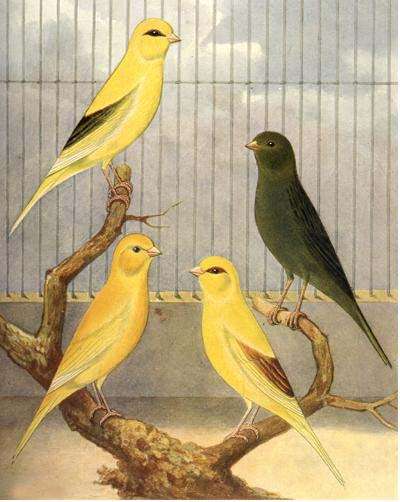 Border Canary or Border Fancy Canary
Border Canary or Border Fancy CanaryThe Border canary, or Border Fancy was developed near the border of Scotland and England...hence the name.
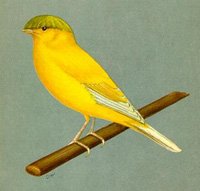 Crested Gloster Canary
Crested Gloster CanaryThe crested Gloster canary looks eerily like John, Paul, George, and Ringo with its moppish hairdo.
The Crested canary has the same mop-top but came before the Gloster and is larger and more rare.
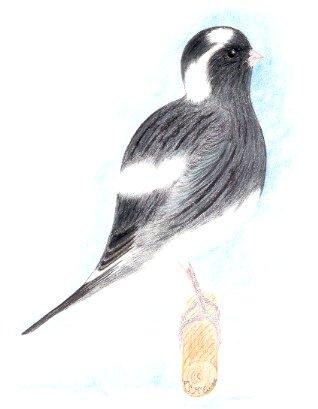 Fife Canary
Fife CanaryThe small and cute Fife canary looks huggable but BE CAREFUL! He can be fragile.
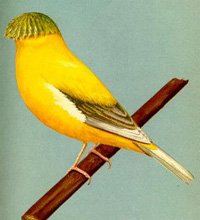 Norwich Canary
Norwich CanaryThe Norwich canary with its "padded" head is one of my favorites.
 Yorkshire Canary or Guardian Canary
Yorkshire Canary or Guardian CanaryThe "Guardian" or Yorkshire canary is referred to as a proud tall-standing gentleman.
Click here for more on Type Canaries.
NOTE: Don't confuse "Type canaries" with "Canary Types"...they're 2 different things. Canary types are the three groupings of canaries defined by the purpose of their breeding. As mentioned, the three canary types are Type, Color, and Song.
Next are the...
2. Color Canaries
 Red Color Canary
Red Color CanaryColor canaries are bred for color...imagine that.
The variation of colors and color schemes bred into canaries is FLABBERGASTING! Of course, you have the standard yellow but don't forget the light yellow, dark yellow, and intensive yellow.
Dig a little deeper and you'll find...green, orange, red, white, gray, not to mention...orange agate, frosted orange agate, Red Bronze, Orange Brown, Frosted Orange Brown, Frosted Red Orange Brown...WHEW! The list goes on and on and on...
The average canary buyer LIKELY won't end up with any of the Color canaries as pets. They tend to circulate among breeders only for the purpose of exhibiting in shows...except for the Red Factor.
Red Factor Canaries. If you end up with a Color canary it will probably be the red. They are by far the most popular of the color canaries.
Typically when the average person shops for a canary they want one that has a pretty song. And that brings us to the third of the types of canaries...
3. Song Canaries
Song canaries are bred for...guess what...SONG.
This canary type can be broken down even further into types of song...
- soft
- loud
- trilled
- rolling
- etc
The song is of course what canaries are generally known for. The other two canary types do sing but not as remarkably as the song canary. No other bird has such a beautiful song.
Popular Song canaries are...
The American Singer, which was developed in the U.S.A. in the 1930's and 40's, is the most popular pet canary in the U.S. The American Singer is hailed by many to be the best canary to be kept as a pet. One reason is their great singing voice but also because they're known to be especially robust and healthy.
Click here for more on the American Singer.
The German Roller gets its name from the rolling tours of its song. Often said to have the most beautiful song of all the canaries the German Roller Canary has been bred in Germany for 300 years...and some say they've nearly perfected the breed! Click here for more on the German Roller.
The Russian Singer is one of the least known canaries however it is gaining popularity earth wide. The breed got its' start when Russian canary breeders realized their German canaries could...Click here to read more on the Russian Singer
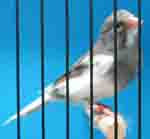 Spanish Timbrado Canary
Spanish Timbrado CanaryThe Spanish Timbrado. The newest and L-O-U-D-E-S-T variety of all the canary types. The Spanish Timbrado canary is an interesting variety because he is closest to...Click here for more on the Spanish Timbrado
The Waterslager canary has a fascinating way of mimicking running water. This intriguing babbling brook sound is how the Waterslager got its name. Click here for more on the Waterslager
More on the Song Canary Type...click here.
You can discover more about the canary types AND about canary care by subscribing to CanaryAdvisor.com'sCanary Tips! Ezine.
Canary Tips! delivers only original and immediately usable information on canary care that keeps your canary SINGING!
Quick tips and in-depth articles regarding canary feeding, housing, health care, disease prevention and treatment, breeding, and canary psychology to help you understand your bird better.
Even if you don't have a canary bird yet...Canary Tips! will prepare you for bringing home your first canary.
Sign up here...It's FREE...
Return from Canary Types to CanaryAdvisor.com Home.









